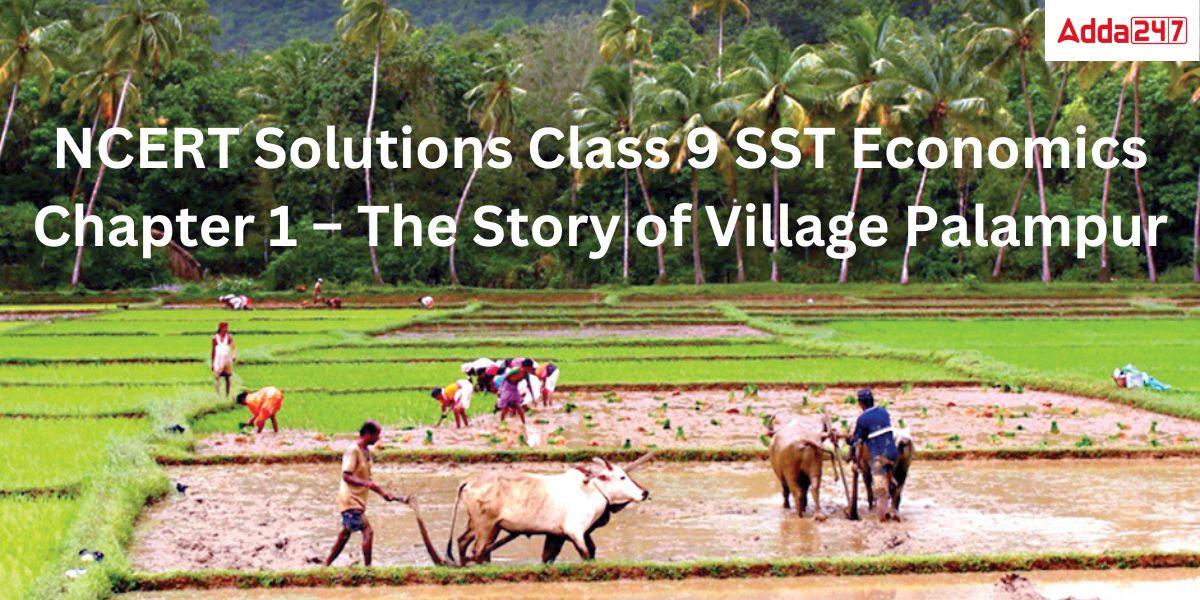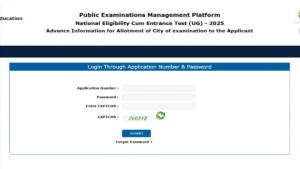NCERT Solutions for Class 9 SST Economics Chapter 1 The Story of Village Palampur
NCERT Solutions for Class 9 SST Economics Chapter 1 – The Story of Village Palampur notes are provided in this article. NCERT Solutions for class 9 is the finest resource for getting a high score on the class 9 Examination. Adda247 Expert faculty team prepared NCERT Solutions for Class 9 SST Economics Chapter 1 – The Story of Village Palampur exercises of that chapter for a better grasp of the topics. These NCERT Solutions answer all questions in an easy and simple manner. These solutions will help you understand the concepts covered in the chapter completely. By writing these answers in the exam students will undoubtedly be able to achieve high scores. Keep learning with Adda247.
NCERT Solutions for Class 9 SST Economics Chapter 1 The Story of Village Palampur Pdf
NCERT Solutions for Class 9 SST Economics Chapter 1 – The Story of Village Palampur Pdf is given in pdf format so students can easily download it for future use. Click here to download NCERT Solutions for Class 9 SST Economics Chapter 1 – The Story of Village Palampur
Class 9 SST Economics Chapter 1 The Story of Village Palampur Video Explanation

Class 9 SST Economics Chapter 1 The Story of Village Palampur Summary
Class 9 Social Science Economics Chapter 1 The Story of Village Palampur explains d in Class 9 will enjoy reading The Story of Village Palampur. how rural people in places like Palampur produce crops and engage in other non-farm vocations is a unique way. The following are the main topics covered in this chapter:
1. Organisation of Production
- Fixed capital and working capital
- Factors of Production
2. The type of farming in Palampur. The crops grown and the techniques used to grow crops. Factors like the distribution of land, labour, land sustainability and the capital needed.
3. Non-Farming Activities
- Dairy
- Transport
NCERT Solutions for Class 9 SST Economics Chapter 1 The Story of Village Palampur Questions with Answers
1. Every village in India is surveyed once in ten years during the Census and some of the details are presented in the following format. Fill up the following based on information on Palampur.
- LOCATION:
- TOTAL AREA OF THE VILLAGE:
- LAND USE (in hectares):
| Cultivated Land | Land not available for cultivation (Areacovering dwellings, roads,ponds, grazing ground) | |
| Irrigated | Unirrigated | |
| 26 hectares | ||
d) FACILITIES:
| Educational | |
| Medical | |
| Market | |
| Electricity Supply | |
| Communication | |
| Nearest Town |
Answer:
a. Location: Bulandshahr District (Uttar Pradesh West)
b. Total Area of the Village: 226 hectares
c. Land Use (in hectares):
| Cultivated Land | Land not available for cultivation (Areacovering dwellings, roads,ponds, grazing ground) | |
| Irrigated | Unirrigated | |
| 200 hectares | 26 hectares | |
d) FACILITIES:
|
Educational |
2 primary schools & 1 high school |
|
Medical |
1 state run primary health care centre, 1 private dispensary |
|
Market |
2 Main Markets: Raiganj & Shahpur |
|
Electricity Supply |
Almost most of the homes are connected to power. All of the tubewells in the fields are powered by electricity, which is also used for numerous small businesses. |
|
Communication |
Neighboring towns are well-connected, with Raiganj about three kilometers away. Jaggery-carrying bogeys, tongas, and bullock carts are examples of appropriate conveyance. In addition, there are motorized vehicles such as trucks, jeeps, tractors, and motorcycles for convenient transit. |
|
Nearest Town |
Shahpur |
2. Modern farming methods require more inputs which are manufactured in industries. Do you agree?
Answer: It is true that more industrially produced inputs are needed for modern farming techniques. Compared to traditional farming techniques, modern farming methods utilize more industrial outputs. High-yielding seeds are used in modern farming techniques. In order to yield the best results, these seeds need pesticides, chemical fertilizers, agricultural machinery made in factories (like tractors), and cutting-edge irrigation systems (like electric tube wells). Consequently, traditional farming practices rely less on industrial outputs because they use relatively low-yielding varieties of seeds as well as cow dung and other natural manures as fertilizers.
3. How did the spread of electricity help farmers in Palampur?
Answer: The arrival of electricity benefited the farmers in Palampur since it had a significant impact on the irrigation system. Farmers up to that point employed Persian wheels to pull water from wells and irrigate tiny areas. People saw that electric-powered tubewells could successfully water considerably bigger amounts of land. The government put in the first few tubewells. But soon farmers began constructing their personal tubewells. Thus, by the middle of the 1970s, irrigation had been installed throughout the 200 acres of cultivable land.
4. Is it important to increase the area under irrigation? Why?
Answer: In India, farming provides the majority of the population’s income, but less than 40% of the country’s land is suitable for cultivation, making it crucial to expand the area under irrigation. In other regions, agriculture is dependent on irregular rainfall. Applying modern farming techniques when there is insufficient water is particularly tough. India won’t be able to produce enough food grains on its own unless more land is provided for irrigation. Consequently, it is important to expand the area cultivated.
5. Construct a table on the distribution of land among the 450 families of Palampur.
Answer.The distribution of land among the 450 families of Palampuris as
| Area of land Cultivated | Number of Families |
| 0 | 150 |
| Less than 2 hectares | 240 |
| More than 2 hectares | 60 |
6. Why are the wages for farm labourers in Palampur less than minimum wages?
Answer: Farm laborers in Palampur who are landless typically receive pay below the government-set minimum wage. The government specified daily compensation for farm laborers is Rs 300, however, due to intense competition for jobs, many farm labourers are ready to accept lower pay.
7. In your region, talk to two labourers. Choose either farm labourers or labourers working at construction sites. What wages do they get? Are they paid in cash or kind? Do they get work regularly? Are they in debt?
Answer: Students are required to complete this task independently and provide an original response to the question based on their survey.
8. What are the different ways of increasing production on the same piece of land? Use examples to explain.
Answer:
Multiple farming refers to the practise of growing more than one crop on a given amount of land at a time.On a particular plot of land, it is the most typical method of boosting production.
For instance, Jowar and bajra are grown by farmers during the rainy season (kharif). Potatoes are then grown between October and December after that. Wheat is sown in the fields throughout the winter (rabi).
Cultivable regions are employed in modern farming, when HYV seeds and irrigation are applied. Tractors are employed instead of simple wooden ploughs to harvest the crops, transport them to markets, and increase productivity by using fertilisers or pesticides.
9. Describe the work of a farmer with 1 hectare of land.
Answer: Small farmers are those who own less than one hectare of land and who work the land together with their families. Plowing, planting seeds, harvesting, and bringing the finished product to market are major tasks. The farmer will plough the field using a pair of bullocks. He might require a few workers during harvest time. The result may not be as great because the cultivation area is tiny, thus the farmer needs money to be able to acquire the highest output. A moneylender charges a high-interest rate for the money, and occasionally the borrower may also be required to perform farm labour for the lender
10. How do the medium and large farmers obtain capital for farming? How is it different from the small farmers?
Answer: Medium and large farmers can easily obtain loans from banks because they own a home and land. From a portion of their yield, large and medium farmers sell excess agricultural products. A portion of the profits is set aside and used to purchase capital for the coming season. Small farmers produce insufficient amounts due to their small plot sizes. Due to their lack of excess, they are forced to borrow money from local moneylenders because they find it difficult to acquire loans from banks.
11. On what terms did Savita get a loan from Tejpal Singh? Would Savita’s condition be different if she could get a loan from the bank at a low rate of interest?
Answer: Small-scale farmer Savita intended to grow wheat on her 1-hectare property. In order to buy pesticides, seeds, and fertilizers, as well as water for irrigation and farm equipment repairs, Savita required money. She calculated that the cost of his working capital would be at least Rs 3,000. She decided to borrow money from Tejpal Singh, a significant farmer in her village because she lacked the funds. Tejpal Singh was persuaded to agree to a loan of Rs. 3000 with a four-month repayment period and a 24% interest rate. which carried a hefty interest rate. He agreed to pay Savita Rs 100 every day to labour on his field during the harvest.
She could concentrate on her land rather than working as a labourer in Tejpal Singh’s field for a pitiful income if she could obtain a loan from the bank with a low-interest rate.
12. Talk to some old residents in your region and write a short report on the changes in irrigation and changes in production methods during the last 30 years.
Answer:Students are required to complete this task independently and provide an original response to the question based on their survey.
13. What are the non-farm production activities taking place in your region? Make a short list.
Answer: The non-farm production activities taking place in our region are as follows:
- Dairy
- General Stores
- Fishing
- Transportation
- Mining
14. What can be done so that more non-farm production activities can be started in villages?
Answer: To encourage non-farm activity, adequate infrastructure, training, and resources must be made available. Additionally, the government needs to offer low-interest loans as a kind of finance. Villagers’ access to electricity needs to be increased. Small-scale industries will be encouraged to establish as a result. To encourage non-farm production activities, it is also essential that there is good transportation connectivity between cities and villages. To enable the sale of the manufactured items, proper markets should be set up.
NCERT Solutions Class 9 SST Economics Chapter 1 The Story of Village Palampur-FAQs
Q. What is the total area of village Palampur Class 9?
The village’s total area is the answer. 226 hectares make up Palampur.
Q, What was the central idea of the Village of Palampur story?
The narrative’s goal is to convey certain fundamental production concepts, which we accomplish by telling the tale of a fictitious village called Palampur. * In Palampur, farming predominates over other activities including small-scale manufacturing, dairy production, transportation, etc.
Q.How can I access the online PDF version of the NCERT Solutions for Class 9 SST Economics Chapter 1 – The Story of Village Palampur?
Ans. The NCERT Solutions for Class 9 SST Economics Chapter 1 – The Story of Village Palampur PDF may be downloaded using the link in the article.
Q. What are the advantages of using Adda247’s NCERT Solutions for Class 9 SST Economics Chapter 1 – The Story of Village Palampur?
Ans. The advantages of using NCERT Solutions for Class 9 SST Economics Chapter 1 – The Story of Village Palampur from Adda247 include the following:
- The NCERT solution as well as a video explanation
- Additionally, a PDF is included, which can be downloaded and saved for future use








 NEET City Intimation Slip 2025 Available...
NEET City Intimation Slip 2025 Available...
 CUET Date Sheet 2025 Expected Today @cue...
CUET Date Sheet 2025 Expected Today @cue...
 CUET Biology Chapter Wise Weightage 2025...
CUET Biology Chapter Wise Weightage 2025...










